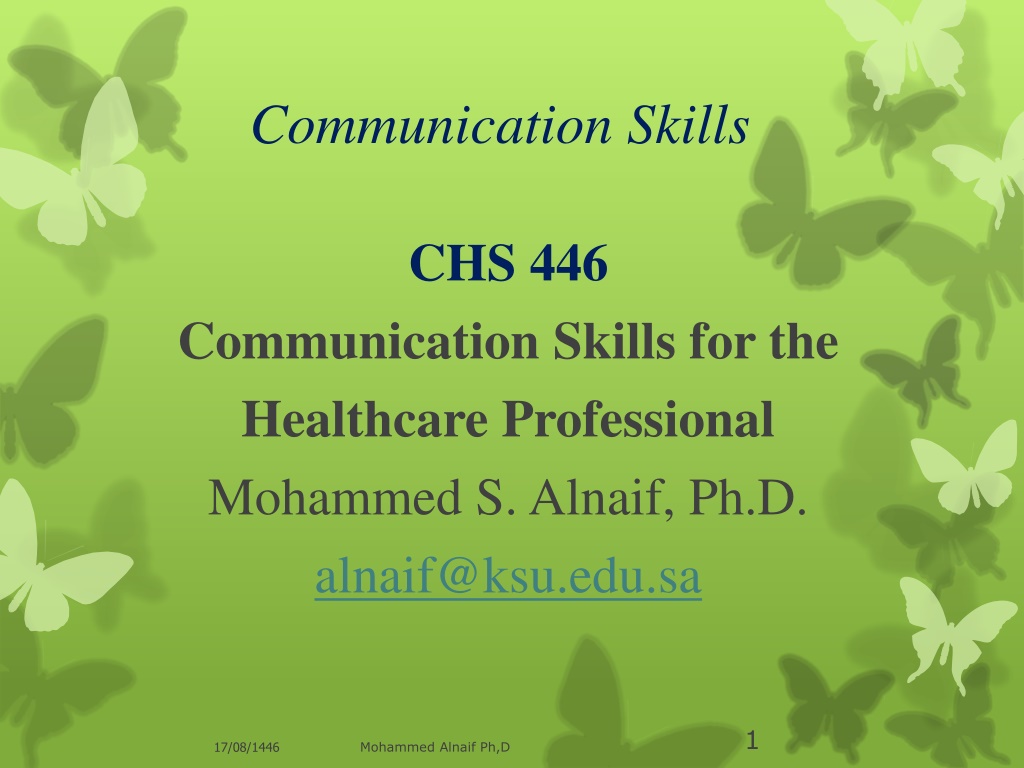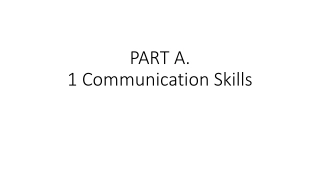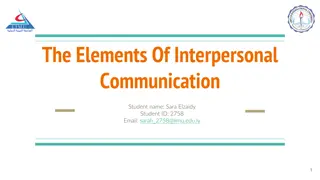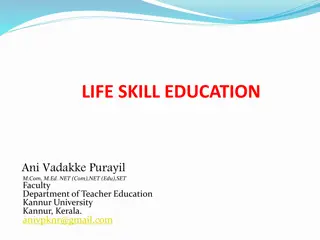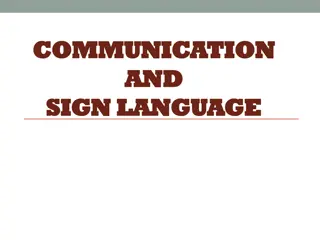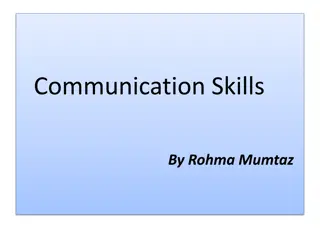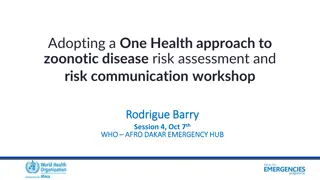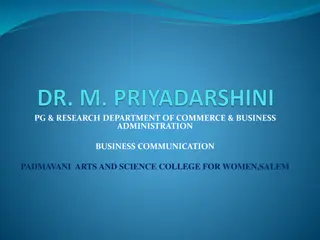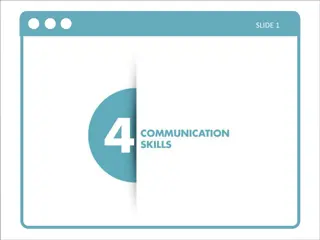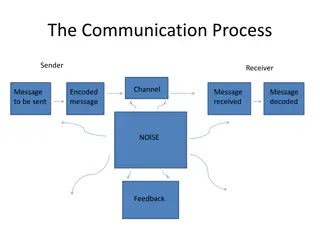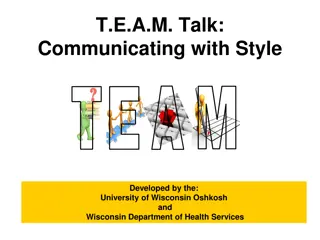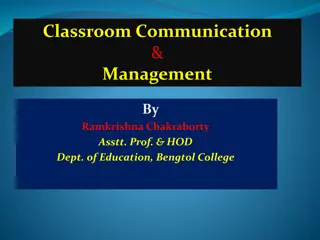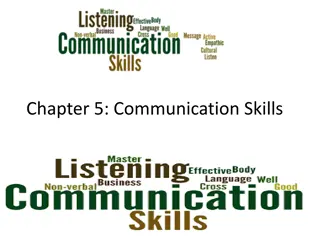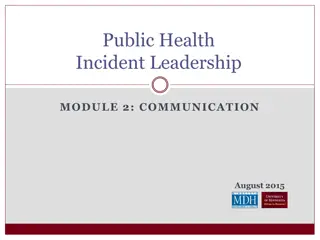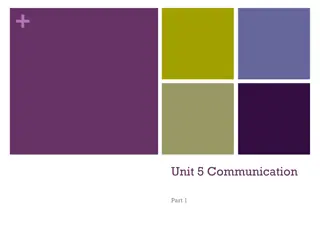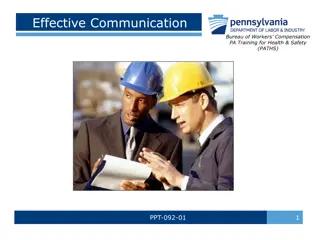Communication Skills
Mastering patient interviewing techniques is crucial for healthcare professionals to gather accurate information, build rapport, and educate patients effectively. This comprehensive guide covers key aspects such as establishing rapport, obtaining medical histories, and understanding the different approaches to patient interviews. Learn how to conduct interviews with professionalism, trust, and confidentiality to enhance patient care outcomes.
Download Presentation

Please find below an Image/Link to download the presentation.
The content on the website is provided AS IS for your information and personal use only. It may not be sold, licensed, or shared on other websites without obtaining consent from the author.If you encounter any issues during the download, it is possible that the publisher has removed the file from their server.
You are allowed to download the files provided on this website for personal or commercial use, subject to the condition that they are used lawfully. All files are the property of their respective owners.
The content on the website is provided AS IS for your information and personal use only. It may not be sold, licensed, or shared on other websites without obtaining consent from the author.
E N D
Presentation Transcript
Communication Skills CHS 446 Communication Skills for the Healthcare Professional Mohammed S. Alnaif, Ph.D. alnaif@ksu.edu.sa 1 Mohammed Alnaif Ph,D 17/08/1446
Interviewing Techniques Interviewing Techniques An important and fundamental step in providing medical care is the patient interview. To properly diagnose the patient s conditions and to develop the appropriate treatment plan, the healthcare professional, needs to obtain thorough and accurate medical history from the patient. 2 Mohammed Alnaif Ph,D 17/08/1446
Interviewing Techniques Interviewing Techniques There are three primary functions of the medical interview: Information gathering Relationship building Patient education 3 Mohammed Alnaif Ph,D 17/08/1446
The Interview Interviewing Techniques Interviewing Techniques Subjective data The interview as a contract between patient and examiner Time and place Introduction and explanation Purpose Length Expectations Confidentiality Mohammed Alnaif Ph,D 4 17/08/1446
Establish Rapport Establish Rapport Get organized Do not rely on memory Plan enough time Ensure privacy Get focused Be calm, confident, warm, and helpful
Interviewing Techniques Patient Interview There are two common approaches to the patient interview: The primary care provider only approach, primary care providers interview the patient themselves. In this way the patient is required to relate their medical history only once. The team approach, the patient is interviewed more than once. The first interview is conducted by a member of the healthcare team, such as a nurse or a medical assistant. This is followed by a subsequence interview conducted by the primary provider, such as a physician, physician assistant, or nurse practitioner. 6 Mohammed Alnaif Ph,D 17/08/1446
Interviewing Techniques Patient Interview The practitioner patient relationship is often an unequal one. Healthcare Professionals are knowledgeable about their area of practice and the patient is dependent upon this expertise HCP should display an attitude of competence and professionalism and also communicate a sense of trust and confidentiality. 7 Mohammed Alnaif Ph,D 17/08/1446
Interviewing Techniques The Interviewee The patient is typically the primary source of medical information for this reason; the HCP will interview the patient directly. There are also instances in which the patient may be unable to provide their medical history directly to the practitioner. 8 Mohammed Alnaif Ph,D 17/08/1446
Interviewing Techniques The Interviewee Patients who are critically ill, or even unconscious, mentally impaired, or very young cannot effectively communicate with their caregivers. In these cases, other sources are necessary to provide the required medical information. Family Members Other healthcare team members Medical records 9 Mohammed Alnaif Ph,D 17/08/1446
Interviewing Techniques The Interviewee The presence of family members during the visit may offer many significant benefits during the medical interview. Family members may help communicate the patient s concerns to the HCP Improve the HCPs understanding of the patient s problem Improve the patient s understanding of the diagnosis and treatment Help the patient to remember clinical information and recommendation Express concerns regarding the patient Assist the patient in making decisions 10 Mohammed Alnaif Ph,D 17/08/1446
Interviewing Techniques The Setting The interview between the HCP and the patient may take place face-to-face in the doctor s office or in a hospital or a clinic. Patients should be escorted to an area that is both private and comfortable, usually the examination room. This way patient confidentiality is maintained The HCP provider is able to observed any nonverbal behaviors exhibited by the patient These observations which may be helpful in diagnosing the patient or in developing the treatment plan should be noted on the medical history form. 11 Mohammed Alnaif Ph,D 17/08/1446
Interviewing Techniques The Setting The patient interview may also take place on the telephone. In this case, the HCP is unable to observe the patient s facial expressions, cannot make eye contact with the patient, and is unable to receive any visual feedback, such as body language. Instead the practitioner conducting the interview relies on the patient s tone, pacing of speech, and word selection to interpret their condition and attitude. 12 Mohammed Alnaif Ph,D 17/08/1446
Interviewing Techniques How to ask Questions? Ask about the main problem first = chief complaint Focus your questions to gain specific information about the signs and symptoms Don t lead the witness Carefully assess areas connected to verbal cues Use your senses Note general appearance Observe body language Notice interaction patterns
Interviewing Techniques Type of Questions There are two types of questions that the HCP will ask the patient during the interview: Closed direct questions and open-ended questions. Closed questions are designed to elicit short, focused responses such as simple yes and no. Have you ever had rheumatic fever? Have you ever had jaundice or hepatitis? Do you use tobacco? 14 Mohammed Alnaif Ph,D 17/08/1446
Interviewing Techniques Type of Questions Other examples of closed questions Where does it hurt? Did you have a fever this morning? Closed questions quickly provide a great deal of objective information about the patient. The HCP will only have 15 minutes with the patient, and these questions will allow for the most efficient communication. 15 Mohammed Alnaif Ph,D 17/08/1446
Interviewing Techniques Type of Questions Open-ended questions Conversely much important information, both objective and subjective, regarding the current physical and emotional conditions of the patient can be obtained only by way of open-ended questions. These questions often begin with who, what, where, when, how, and why. Open-ended questions cannot be answered simply and require more discussion regarding a given health issue. 16 Mohammed Alnaif Ph,D 17/08/1446
Interviewing Techniques Type of Questions Open-ended questions These are the questions that help to establish therapeutic communication and relationship between the patient and the HCP The patient is required to provide more explanation when responding to these questions. Open-ended questions often begin with how or what. Examples of these questions include the following: How are your stress levels at work? How does this pain feel like? 17 Mohammed Alnaif Ph,D 17/08/1446
Interviewing Techniques Type of Questions Open-ended questions Open-ended statements may also be useful Describe when this occurs Give me an example Why don t you take your medication? Why did you do that? There may be no one true answer to the why question, as a patient s motivation is often complex. 18 Mohammed Alnaif Ph,D 17/08/1446
Interviewing Techniques Type of Questions Open-ended questions In addition, these questions may be perceived as confrontational. The patient may feel as though they have to defend themselves, this likely to inhibit further communication and damage the therapeutic relationship between the practitioner and the patient. On the other hand, there are times when WHY questions are useful. 19 Mohammed Alnaif Ph,D 17/08/1446
Interviewing Techniques Type of Questions Open-ended questions For example, to engage in true collaborative decision making it is necessary for the HCP to know what motivates the patient. The HCP will often need to ask the patient about the factors that might influence their ability to follow a certain treatment regimen. Why are concerned about taking this medication? Why are you worried about starting this diet? 20 Mohammed Alnaif Ph,D 17/08/1446
Interviewing Techniques Type of Questions Open-ended questions These questions are meant to improve the HCP s understanding of how the patient feels about a given issue. The use of leading questions and statements should be avoided I assume you have shortness of breath. These types of questions or statements are likely to prompt or encourage the patient to provide what they perceive is the desired answer. 21 Mohammed Alnaif Ph,D 17/08/1446
Interviewing Techniques Type of Questions Open-ended questions If the patient does not fully understand the content of the question, they may compelled to simply go along with the HCP to avoid appearing disagreeable. These responses may in fact, be inaccurate and have a negative impact on the medical interview. Indirect statements are used to establish therapeutic communication and relationship between the practitioner and the patient. till me about the diet you are on 22 Mohammed Alnaif Ph,D 17/08/1446
Interviewing Techniques The HCP-centered Interview versus the Patient-centered Interview Consider the following interview between a healthcare professional and their patient: HCP: What brings you hear today? Patient: I have chest pain. HCP: How severe is it? When does it occur? What do you do to relieve it? This is an example of a healthcare centered interview where the healthcare provider controls the dialog. 23 Mohammed Alnaif Ph,D 17/08/1446
Interviewing Techniques The HCP-centered Interview versus the Patient-centered Interview The stream of questions in response to the patient s first compliant may, in fact, interrupts the patient, and may prevent the patient from continuing to express all of their concerns. 24 Mohammed Alnaif Ph,D 17/08/1446
Interviewing Techniques The HCP-centered Interview versus the Patient-centered Interview Contrast the previous interview with the following interview: HCP: What brings you hear today? Patient: I have chest pain. HCP: What else? Patient: I have been having a lot of trouble sleeping. HCP: Anything else? Patient: Well I have been very worried about my job . I am afraid that I may be laid off. 25 Mohammed Alnaif Ph,D 17/08/1446
Interviewing Techniques The HCP-centered Interview versus the Patient-centered Interview This is an example of a patient-centered interview where the HCP uses continuers expressions that encourage the patient to reveal all of their concerns at the beginning of the interview. The HCP allows the patient to tell their story and guides the patient to provide the important details by using both open- ended questions and indirect statements as well as specific closed questions. This approach provides the best information 26 Mohammed Alnaif Ph,D 17/08/1446
Interviewing Techniques The HCP-centered Interview versus the Patient-centered Interview This approach provides the best information. The use of continuers also contributes to the development of relationship between the HCP and their patient at the outset of their interaction. Finally the patient-centered approach allows the HCP to be more attentive to the nonverbal messages expressed by the patient. 27 Mohammed Alnaif Ph,D 17/08/1446
Interviewing Techniques How to listen Be an empathetic listener Use short supplementary phrases Listen for feelings as well as words Let the person know when you see body language that conflicts with what they say Be patient if the patient has a memory block Avoid the impulse to interrupt Allow for pauses
The InterviewTechniques of Communication Ten Traps of Interviewing 1. Providing false assurance or reassurance 2. Giving unwanted advice 3. Using authority 4. Using avoidance language 5. Engaging in distancing 6. Using professional jargon 7. Using leading or biased questions 8. Talking too much 9. Interrupting 10. Using why questions
The InterviewTechniques of Communication Nonverbal skills Physical appearance Posture Gestures Facial expression Eye contact Voice Touch Closing the interview
The Interview Interviewing People With Special Needs Hearing-impaired people Acutely ill people People under the influence of street drugs or alcohol Personal questions Sexually aggressive people Crying Anger Threat of violence Anxiety
Charting & Documentation If it isn t written, then it wasn t done Chart at the time it occurs if possible Follow facility guidelines Is the information clear and logical? Is it true? Is it non - judgmental? Record all abnormal and normal
Charting guidelines Be precise Stick to the facts Sign your name after each entry SOAP format focuses on specific problems AIR, DAR, PIE, DIE formats focus on nursing interventions and client response Prioritize the client problems
34 Mohammed Alnaif Ph,D 17/08/1446
THANK YOU 35 Mohammed Alnaif Ph,D 17/08/1446
